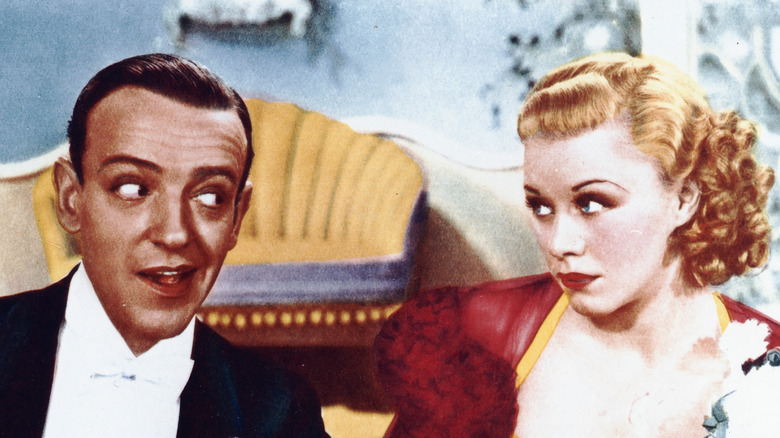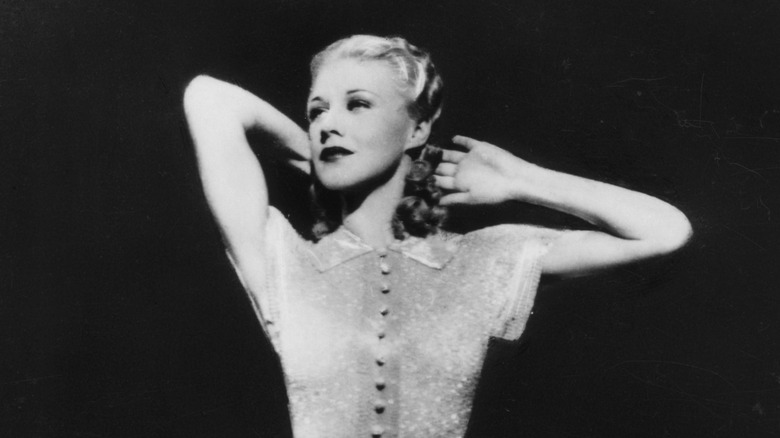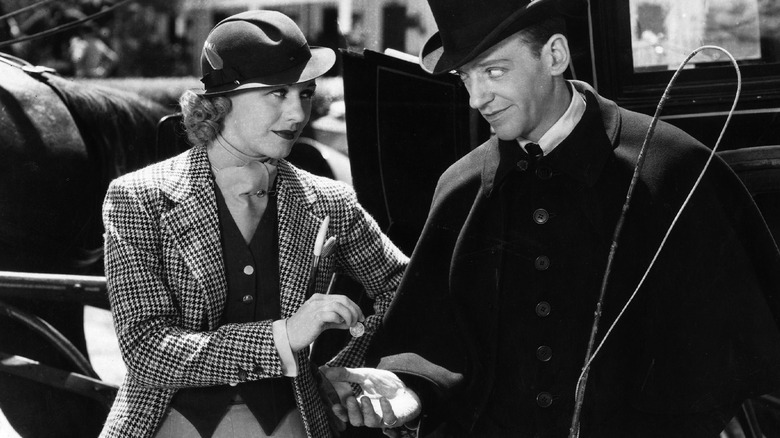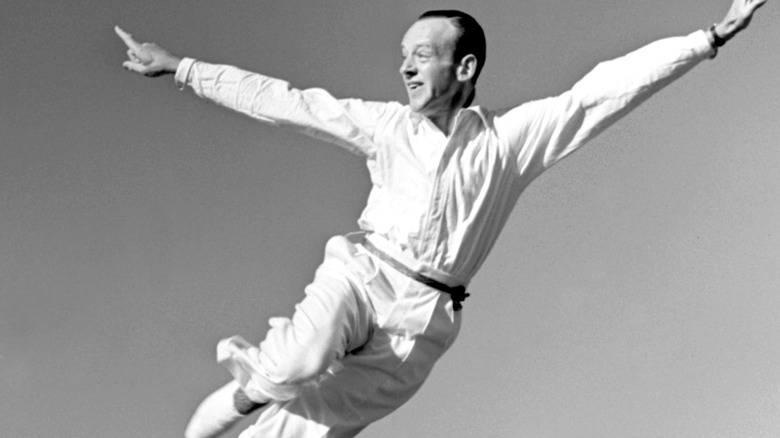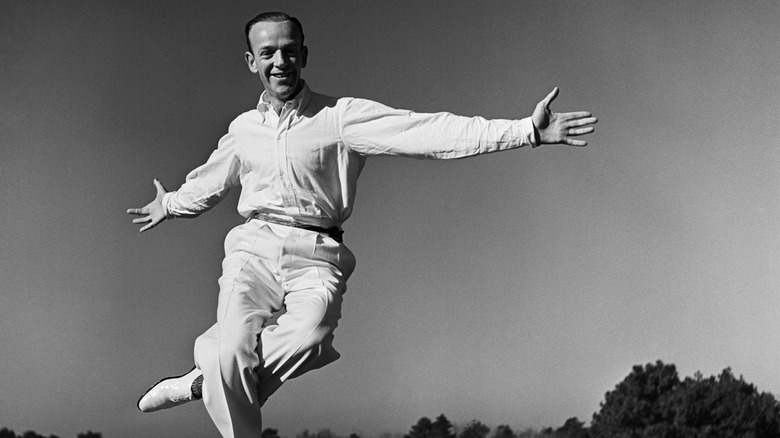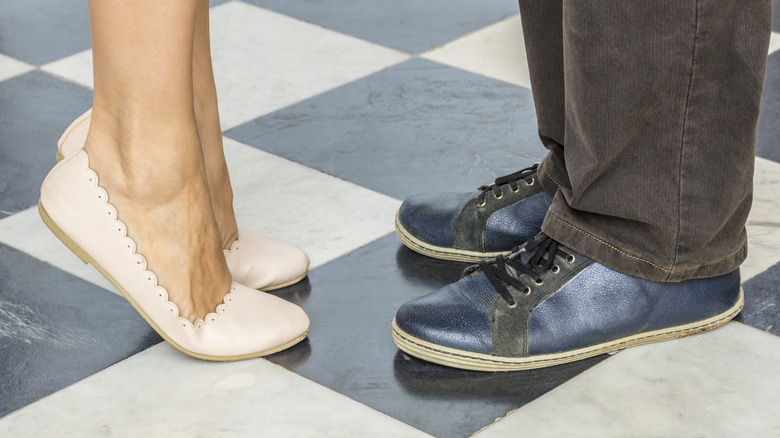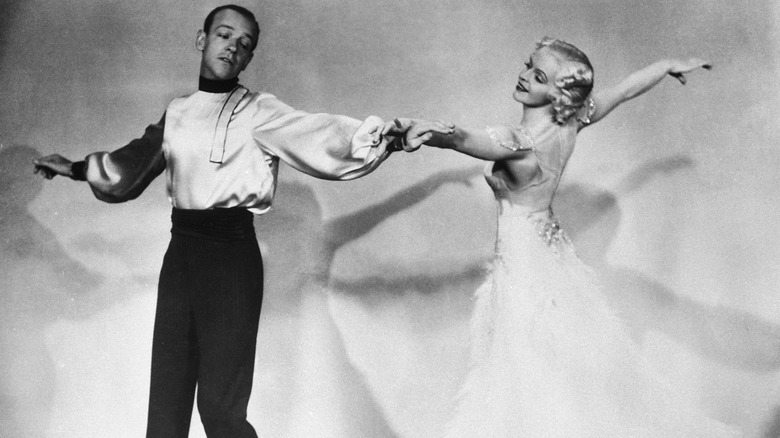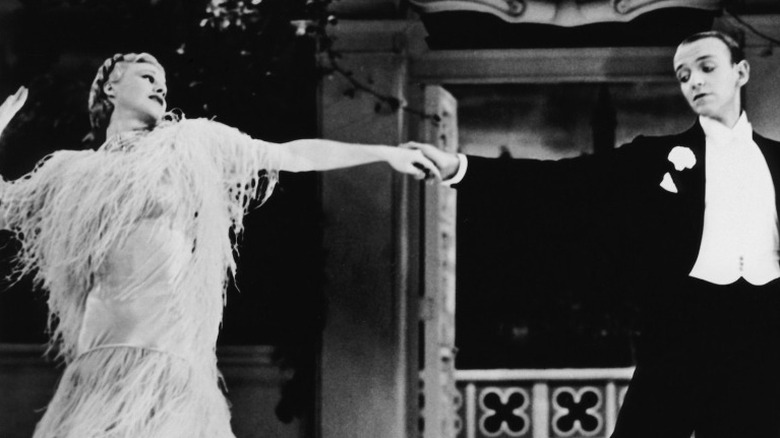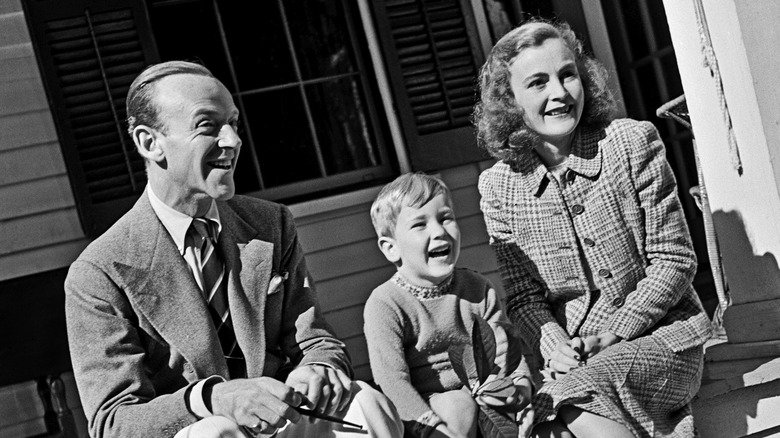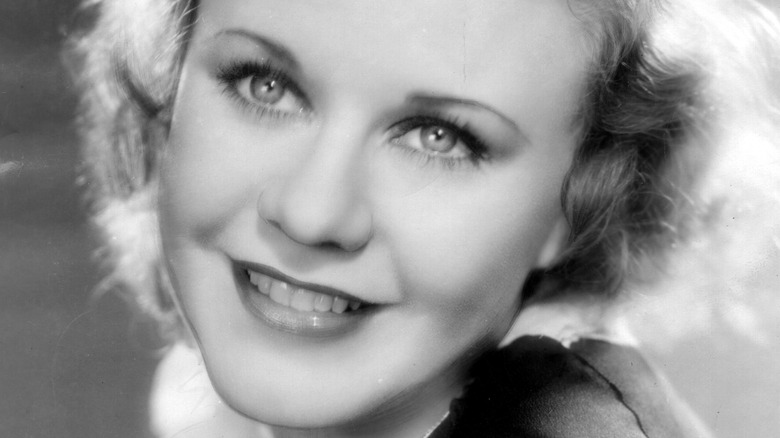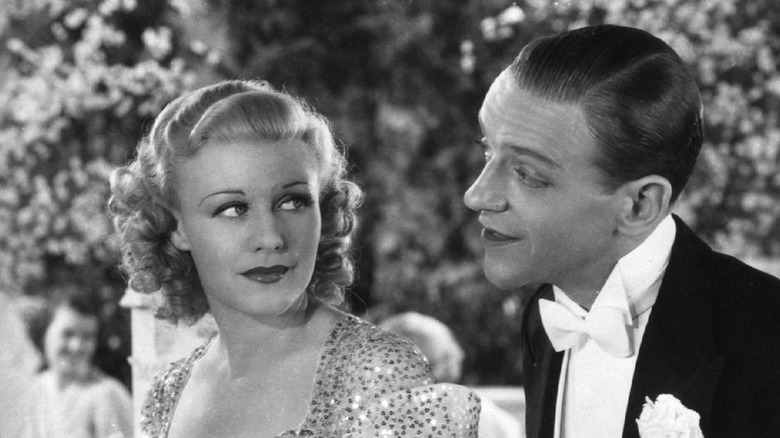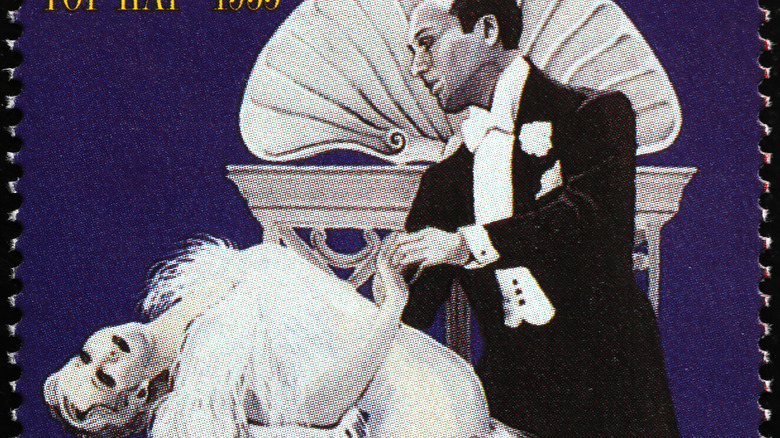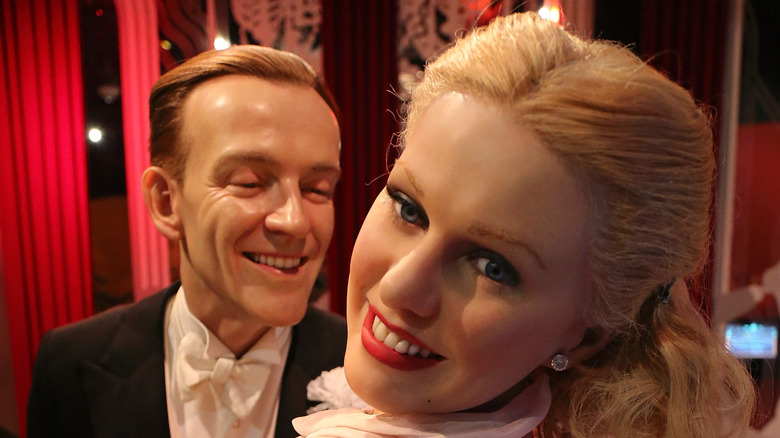Fred Astaire's Relationship With Ginger Rogers Explained
The magic that Fred Astaire and Ginger Rogers created on the silver screen is hard, if not impossible, to top — millions of fans still adore every single jump and turn they made. Their chemistry was undeniable, along with not only the complementary dance moves and humor, but sexual tension. After seeing the pair, one can not help but ask if what's on screen is actually real — did the pair share more than only a professional partnership?
Many rumors were told, and both Astaire and Rogers explained the truth on many occasions, lots of times in vain. No, they were never a couple, although they did share a passionate kiss once. They did not hate each other, as some claim, but they had their differences, stemming mostly from their different personalities and quirks. Astaire got more praise than Rogers, which did cause some bad blood among the pair, understandably more on Rogers' side.
Their initial reluctance to work with each other was quickly forgotten after the massive popularity of their movies. Their partnership didn't last as long as one would imagine, but they did ride the musical wave of the 1930s well, firmly planting themselves in viewers' hearts. They've managed to create an iconic dance couple, while entertaining the public during the Great Depression. In the end, they never lost respect towards each other, always talking about one another in admiring and appreciating tones. Here is Fred Astaire's relationship with Ginger Rogers explained.
Rogers wasn't impressed when they first met
Though their relationship didn't really start until later, by the time Ginger Rogers and Fred Astaire became a duo, they'd already danced with each other. As Rogers describes in her biography, "Ginger: My Story," she and Fred Astaire met on the set of the "Girl Crazy" show in New York in 1930. Alexander Leftwich, dance director of the production, did not invest much energy into the work, so producers Alex Aarons and Vinton Freedley called Astaire for help. His task was to polish dance numbers, so dancers, including Rogers, performed for him.
At some point, he took over for Rogers' partner and danced with her, in the first duet of many more to come. Rogers was not dazzled, although she did appreciate him as a capable choreographer and a dancer who instantly matched with her own movement: "But to me he was just a man summoned to polish a few rough spots. There was no reason to be particularly impressed. I honestly didn't think of him again."
They dated each other for a brief moment
The couple's undeniable on-screen spark never fully evolved into something real in everyday life; on the contrary, the couple was known after their professionalism when working with each other. But, as Ginger Rogers admits further in "Ginger: My Story," there was a moment where a spark could have started a real fire. In 1930, after they had already danced together in a movie studio, Fred Astaire called Rogers and asked her on a date.
Astaire came in a suit and a silk tie, and Rogers chose a silk chiffon dress, both dressed in dark blue. They enjoyed a dinner at the Casino in the Park and some dancing — if Rogers was worried that Astaire was only good dancing on stage, she was reassured that she had a brilliant dance partner in private as well. Musician Eddy Duchin noticed and commented on how good they looked together, and Rogers "felt as though she could have danced all night." They didn't, but they did share a passionate kiss in the car afterwards, lasting for five minutes, according to Rogers.
Their lives went different ways for a while after this brief encounter, and neither of them really acted on their mutual attraction. But, as Rogers recalls: "If I had stayed in New York, I think Fred Astaire and I might have become a more serious item. We were different in some ways but alike in others. Both of us were troupers from an early age, both of us loved a good time, and, for sure, both of us loved to dance."
Astaire didn't want to dance with Rogers at first
As per Arlene Croce in "The Fred Astaire & Ginger Rogers Book," Fred Astaire's life revolved around dance because of his sister Adele — while everyone thought she was destined for fame, he trained as her supporting act. They reached success on Broadway and London's West End, but everything came to halt when Adele married a British aristocrat and left the industry. Astaire was heartbroken, thinking of continuing his career as a soloist. But he did dance in a couple again, this time with Ginger Rogers in "Flying Down to Rio" in 1933. The chemistry was just too good for the movie studios to pass this chance by, so they offered them a second movie.
Upon hearing this proposal, Astaire replied to the producer, "What's all this talk about me being teamed with Ginger Rogers? I will not have it, Leland. I did not go into pictures to be teamed with her, or anyone else," according to the biography "Fred Astaire."
As Rogers notes in "Ginger: My Story," she did know about his feelings at the time, but didn't give much notice. As much as she sympathized with his feelings over Adele, she never opposed the idea of them being a couple on screen: "For every film I did with Fred Astaire, I did three or four without him. Our partnership was a limited one only in his case, not in mine." For her, it was just another movie; for him, it was his whole career.
He was a better dancer then she was
As Hannah Hyam explains in "Fred and Ginger: The Astaire-Rogers Partnership 1934-1938," Ginger Rogers' selling point was never dance. Even though she had considerable stage experience — winning Charleston competitions while she was only 15 and dancing in vaudeville and on Broadway – she wasn't a trained dancer, and that could be seen in her technique. She was more focused on acting skills, dancing only in movies with Fred Astaire.
Astaire on other hand, achieved almost mythological heights when it came to dance; he was known as the dancer, firmly planting an image of a dancing tap man in the minds of millions. As Croce Arlene notes in "The Fred Astaire & Ginger Rogers Book," Rogers was the perfect partner — molding her movement after his, she developed a technique which matched his brilliance, without overshadowing it or being overpowered herself. The result was magical, a unique combination of energy, commented Katherine Hepburn on one occasion (via Encyclopedia).
He made her work harder
Fred Astaire was known for his perfectionism when it came to work, and dance was not an exception. He was equally demanding of his partners, stating on one occasion: "All the girls I ever danced with thought they couldn't do it, but of course they could. So, they always cried. All except Ginger. No, no, Ginger never cried" (via My Plainview).
Rogers was aware of her shortcomings as a self-trained dancer, and she took her performance seriously. As she mentions in "Ginger: My Story," even producer Pandro S. Berman noticed how hard she worked: "She has spent all of her Sundays and holidays and night rehearsing her dances, she has spent many nights after a very long and hard day's work recording her songs, and nothing has been too hard for her, even to the extent of going to the Wardrobe Dept. after midnight and staying there until 2:15 in the morning getting fittings on clothes which were necessary for the next day's work." She speaks about how her feet bled in her satin high heels during filming, but she didn't stop until they'd completed the scene.
She stated she "detests idling," a statement confirmed both by Astaire and Hermes Pan, the dance director of their movies (via Independent).
They only made 10 movies together
While they reached world fame with their incredible dance scenes, Fred Astaire and Ginger Rogers didn't dance together for long — only six years in which they made nine movies together, and another one years later.
As Adrienne L. McLean describes for Oxford Bibliographies, their most fruitful period was the 1930s, the time when the musical genre reached its peak between 1933 and 1934. They started with "Flying down to Rio" in 1933, following with "The Gay Divorcee" in 1934, and two movies in 1935, "Roberta" and the legendary "Top Hat." By this time, the audience was smitten with the dancing pair, their movies continuously selling out box offices. They continued the tempo of a movie per year with "Follow the Fleet" in 1936, releasing two titles again a year later — "Swing Time" and "Shall We Dance" in 1937. They made "Carefree" in 1938 and "The Story of Vernon and Irene Castle" in 1939, finishing their on-screen relationship. They did dance once more 10 years later in 1949 in "The Barkleys of Broadway," but only because Judy Garland lost the role due to her addiction problems, and they called in Rogers at the very last moment.
But their fame lasted much longer than the 1930s, with new generations discovering their dance films every decade. The 1950s and 1960s took their movies from big to small TV screens, while the 1970s brought in a full "nostalgia boom," with RKO Studios re-releasing eight of their films in 1976, followed by later editions on VHS and DVD, which further spread their influence.
He criticized her costumes
As Kimberly Truhler, film and fashion historian, reports on her blog GlamAmor, Fred Astaire had a major influence on the visual style of the movies he participated in. He directed everything, from camera movements to his performance clothes, and he didn't hold back when it came to the clothing of other actors — often commenting on possible improvements or even deciding whether they should use a dress or not.
In "Ginger: My Story," Ginger Rogers describes a situation when they clashed over one of her dresses. During the filming of the "Top Hat" movie in 1935, Rogers worked with the dress designer Bernard Newman on her costumes. For one of the dance numbers she had with Astaire, "Cheek to Cheek," she envisioned a dreamy satin dress covered with ostrich feathers, full of movement and flow. The dress was created, but when the time came for Rogers to wear it on set, the situation got heated. Director Mark Sandrich tried to convince Rogers to wear a different dress, but she insisted, and in the end her mother Lela, her close supporter, had to intervene. It was Astaire who hated the feather dress, mostly due to its impracticability — while they were dancing, feathers flew into Astaire's face, mouth, and all over the dance floor. The next day, Rogers was greeted with dirty looks and a wall of silence from the team on the set, including Astaire. Only a few days later she got his apology, sending her a golden feather with a note: "Dear Feathers, I love ya! Fred."
Astaire's wife affected their relationship
As per Ginger Rogers in "Ginger: My Story," when Rogers and Fred Astaire met again in September 1933, after months of not seeing each other — and some letters from Astaire to which Rogers didn't reply — Astaire's attitude towards Rogers was distant and more rigid than before. He married socialite Phyllis Potter in the meantime, and her stiff nature and possible jealousy affected him greatly. According to Rogers, "she was somewhat insecure in her new role as a famous dancer's wife."
Rogers describes how Phyllis often visited their film sets and asserted her power by loudly knitting in the corner. This made everyone a bit agitated, including Astaire. But Rogers felt Phyllis never really liked her and was very concerned about how close Astaire and Rogers were. She even went as far as consulting Astaire about his scripts and protesting over the possible kissing, or even hugging, in scenes. That is the reason, Rogers believes, why the two never kissed on screen, except once.
Rogers felt she was always in Astaire's shadow
The massive success that followed their musicals was often ascribed more to Fred Astaire than to Ginger Rogers, due to him being a better dancer and also a choreographer who created several dance numbers in their films. But, while he was a better dancer, she was a more skilful actress, even receiving an Academy Award in 1941 for her leading role in "Kitty Foyle." As Hannah Hyam reports in "Fred and Ginger: The Astaire-Rogers Partnership 1934-1938," Rogers was well aware of how their partnership was perceived, mentioning it on several occasions, including in one interview in the 1980s: "It's interesting that people refer to 'the Fred Astaire pictures,' but you see, I was in them too, and so I take umbrage at that." Some critics went as far as saying Rogers was just a puppet in Astaire's hands, only following his instructions, without adding anything on her own.
Rogers was a hard worker and a fighter, carefully choosing her battles. She never forgot about the gender roles in Hollywood, being aware of the differences between how Hollywood treated men and women. In her biography "Ginger: My Story," she mentions how most actresses took a few days from filming while having their periods, but she never did that, not missing a single day of shooting due to period or illness. She did miss work when she was negotiating to get more money, realizing that her willing attitude "allowed herself to miss out on the financial rewards."
They complemented each other
For Fred Astaire and Ginger Rogers, the secret to their success was their complementary characters, pairing with each other perfectly — Astaire's impeccable dancing and Rogers' ability to adapt and improvise with him. As Hannah Hyam discussed with Patricia Guinot for Cineclub Decaen, the pair's ability to convey emotions while dancing, especially romance, was crucial for their success. They exceeded themselves in courtship duets, sometimes cheerful, and thoughtful on other occasions. Even though Astaire danced with other, more skillful partners later on in career, none of them compared to Rogers and her intensity of expression.
According to Jeffrey Escoffier (via Encyclopedia), Rogers and Astaire created a unique style, consisting of "vaudeville, ballroom dancing, tap dancing, soft shoe, and even ballet." Astaire's experiences in ballet and tap equipped them with a foundation, on which Rogers built her movement, molding it to his technique. "He gives her class, and she gives him sex," Katherine Hepburn famously described the pair.
According to Astaire and Rogers, they got along great
While the pair indulged in romance on screen, gossip often appeared that they don't get along in real life, according to Myrna Oliver for the Los Angeles Times. Both Ginger Rogers and Fred Astaire consistently refused to confirm such rumors, Astaire even mentioned it at a tribute event for Rogers in 1979, saying: "There are all kinds of rumors that we used to fight. And we didn't. I've been denying it for the last 20 years or more." Rogers believed the rumors were the studio's fault, trying to gain publicity.
As Rogers herself describes in "Ginger: My Story," all the gossip about how she cried during their work together was absurd, and their relationship as colleagues was never endangered with conflicts; on the contrary, they had a lot of fun together. But, as public figures, people always assumed wrong: "True, we were never bosom buddies off the screen; we were different people with different interests. We were a couple only on film. Because we were so good together, the public tried to make something bigger out of our relationship, even when we were married to other people."
They created each other
There are different versions of this story, depending on who you ask. Many think Ginger Rogers' career really took off only after she started to dance with Fred Astaire, including Arlene Croce in "The Fred Astaire & Ginger Rogers." She notes that Rogers became a star because of her partnership with Astaire, which transformed her whole career. Altering between roles of nice girls and know-it-alls, she never fit the mold — but when the roles were written for her after the success of "Top Hat," she really started to shine.
Rogers disagreed, as she emphasizes in "Ginger: My Story," mentioning that while "Flying down to Rio" was Astaire's second movie, it was also her 20th: "While our union had a special kind of magic and produced unique enchantment, it was not the be-all and end-all of my career." Astaire did honor her great contribution to his career while talking to Raymond Rohauser in 1966: "Ginger was brilliantly effective. She made everything work for her. Actually, she made things very fine for both of us and she deserves most of the credit for our success" (via Quote Park).
As per Jeffrey Epstein in his "Fred Astaire" biography, their success also had a lot to do with the unusual number of great songwriters working in Hollywood at the time, creating catchy numbers for Astaire and Rogers to dance on.
